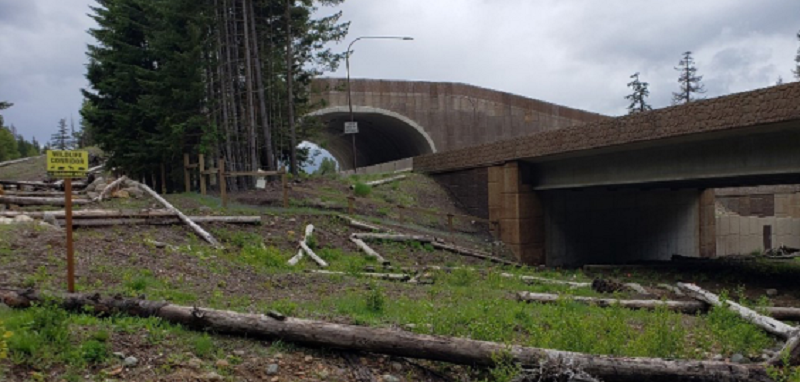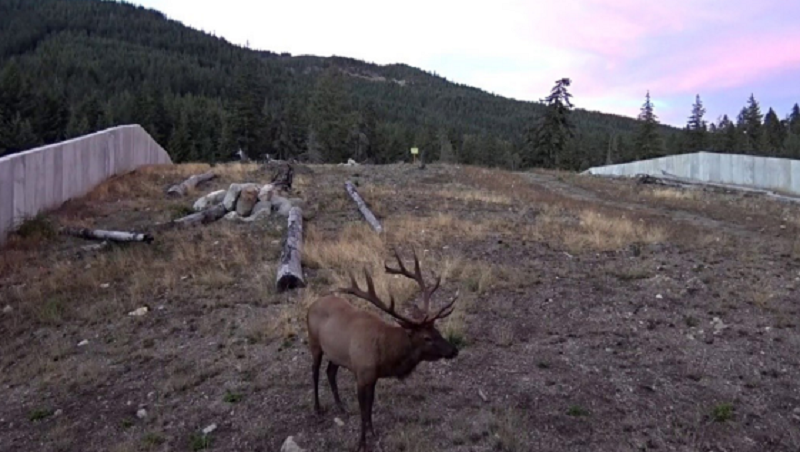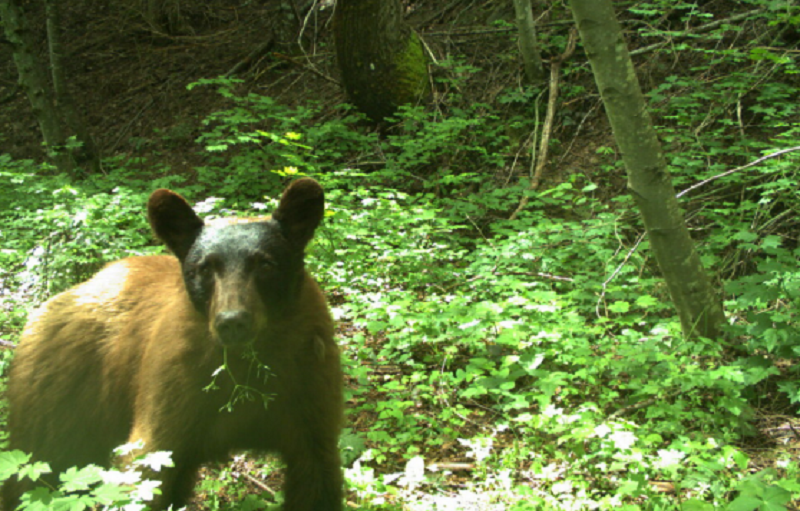Wildlife habitat connectivity - Snoqualmie Pass East Project
Performance analysis
2023
Snoqualmie Pass East Project improves wildlife habitat connectivity
At the end of 2023, WSDOT's motion-activated cameras recorded the 25,000th safe wildlife crossing at completed Snoqualmie Pass East Project structures since 2014. These crossings included:
- 7,967 elk
- 13,525 deer
- 3,216 coyotes
- 6 cougar (5 of which occurred in 2023)
Numerous other crossings by several low-density and rare species like moose, American marten, fisher, and American pika were also made. In 2023 alone, 11 medium and large species were documented using structures on camera, and the highest use of a single structure in a calendar year by elk was recorded: 1,304 crossings on the Keechelus Wildlife Overcrossing.
Monitoring teams from Central Washington University documented many small mammals, amphibians and fish utilizing the crossing structures, including western toads breeding in a wetland south of the overcrossing two years in a row, culminating in newly-metamorphosed western toadlets safely crossing I-90 using the same overcrossing. Furthermore, coastal giant salamanders and American pika were documented crossing I-90 at multiple structures, and federally-threatened bull trout were documented using holding pools beneath the Gold Creek Bridge.
The Snoqualmie Pass East project is located along a 15-mile stretch of Interstate 90 between Hyak and Easton. This corridor passes through the Okanogan-Wenatchee National Forest and is a critical connectivity zone for Pacific Northwest wildlife populations. The project will eventually consist of over 20 large wildlife crossing structures and aims to fulfill multiple objectives, including reducing avalanche and rock fall impacts, replacing failing pavement, adding lanes, reducing the number of wildlife-vehicle collisions and improving ecological connectivity. WSDOT and partners have built 11 large wildlife crossing structures within the completed portions of the Snoqualmie Pass East Project (Phases 1 and 2).
When new wildlife crossings are constructed, it can take time, often years, for different species to discover and become comfortable using them—this is sometimes referred to as the "acclimation period." The acclimation period can result in a lag between when a structure is completed and consistent use is documented. Between 2014-2022, one cougar was detected using a wildlife crossing in the project area (2020), but in 2023, five cougar crossings were documented. For context, there's likely only a handful of cougars whose home ranges overlap the project area due to territoriality. These cougar crossings continued in 2024, indicating increased comfort with using the structures.
Collaboration with stakeholders leads to documenting new species using Snoqualmie Pass East Project crossings
In 2023, monitoring teams from Central Washington University documented many amphibians, fish, and small mammals using the project area crossings multiple times to safely pass the interstate. Furthermore, monitoring teams documented coastal giant salamanders living within artificial streambeds inside multiple structures directly beneath the highway because the structures so closely match natural habitat.
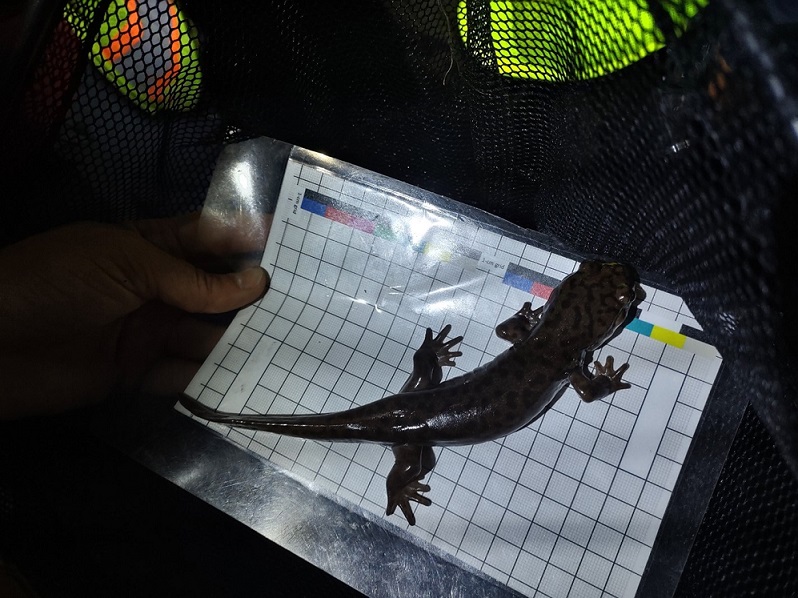
Seven species of fish were documented within the project area in 2023 including Coho salmon, brook trout, cutthroat trout, sculpin, speckled dace, bridgelip sucker, and redside shiner. Cascade golden-mantled ground squirrels were documented for the first time in the project area, and both juveniles and adults were observed using installed habitat features like rock and log piles and berms. The presence of both juveniles and adults indicates a family group and successful reproduction in the area.
The project's final two phases (Phases 3 and 4) will address the remaining portions of the corridor by installing seven additional large wildlife crossing structures, including a second overcrossing, and many small and medium-sized bridges and culverts for water and low-mobility species passage. These final phases will greatly increase habitat connectivity in the area and contribute to further milestones to report. Phase 3 is currently underway.
2022
Snoqualmie Pass East Project improves wildlife habitat connectivity
At the end of 2022, WSDOT recorded the 20,000th safe wildlife crossing by camera at completed structures within the ongoing Snoqualmie Pass East Project, where WSDOT and partners have built 11 large wildlife crossing structures so far. These crossings included 5,959 elk, 12,068 deer, 2,016 coyote and several crossings by rare species like moose, cougar, American marten, fisher, and American pika.
The Snoqualmie Pass East project is located along a 15-mile stretch of I-90 between Hyak and Easton. This corridor passes through the Okanogan-Wenatchee National Forest and is a critical connectivity zone for Pacific Northwest wildlife populations. Ecological connectivity components of the project include more than 20 large wildlife crossing structures, including two major overpasses, and continuous wildlife fencing throughout most of the project area. In addition to improving ecological connectivity across I-90, the project aims to fulfill multiple objectives, including reducing avalanche and rock fall impacts, replacing failing concrete pavement, and adding lanes to reduce congestion.
In August 2022, a moose was documented using a wildlife underpass within the Snoqualmie Pass East Project area to cross I-90, heading south. This moose was approximately 100 miles from its known core range. A couple weeks later, the first moose ever documented in western Washington was recorded in the Cedar River Watershed, and another couple months later, Mount Rainier National Park recorded its first ever moose visitor. While it can't be known with absolute certainty whether it was the same moose it is extremely likely. Wildlife underpass structures allow thousands of safe wildlife crossings annually and give animals opportunities to naturally expand their range into suitable habitats previously unreachable due to transportation infrastructure. Meanwhile, wildlife-vehicle collisions within the completed areas of the Snoqualmie Pass East Project dropped to a consistently low or non-existent level.
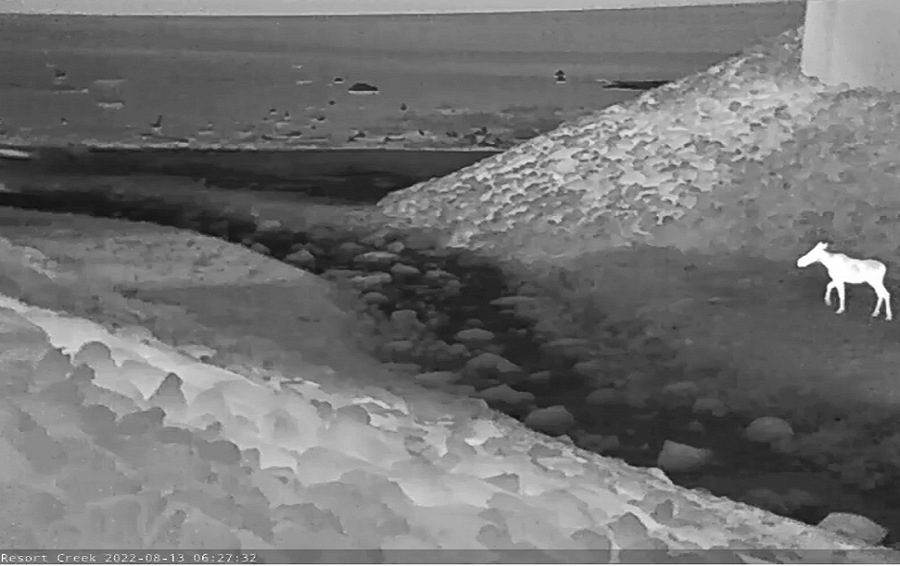
Monitoring teams from Central Washington University documented many small mammals, amphibians and fish utilizing the crossing structures, including western toads breeding in a wetland south of the overcrossing two years in a row, culminating in newly-metamorphosed western toadlets safely crossing I-90 using the same overcrossing. Furthermore, coastal giant salamanders and American pika were documented crossing I-90 at multiple structures, and federally-threatened bull trout were documented using holding pools beneath the Gold Creek Bridge.
The project's final two phases (Phases 3 and 4) will address the remaining portions of the corridor by installing seven additional large wildlife crossing structures, including a second overcrossing, and many small and medium-sized bridges and culverts for water and low-mobility species passage.
2021
Snoqualmie Pass East Project improves wildlife habitat connectivity
The Snoqualmie Pass East (SPE) Project is located along a 15-mile stretch of I-90 between Hyak and Easton. This corridor passes through the Okanogan-Wenatchee National Forest and is a critical connectivity zone for Pacific Northwest wildlife populations. The project aims to fulfill multiple objectives, includingreducing avalanche and rock fall impacts, replacing failing concrete pavement, adding lanes to reduce congestion, and improving ecological connectivity across I-90. The project will enhance ecological connectivity for multiple wildlife species at 14 connectivity emphasis areas. Ecological connectivity components include more than 20 large wildlife crossing structures, including two major overpasses, and continuous wildlife fencing installed throughout most of the project area.
Within the completed portions of the Snoqualmie Pass East Project, WSDOT and partners built 11 large wildlife crossing structures.
WSDOT recorded a minimum of 8,683 wildlife crossings by camera in 2020 and 2021. These included 3,202 elk crossings, 4,382 deer crossings, 764 coyote crossings and several low-density and rare species like cougar, American marten, fisher, and American pika taking advantage of the structures to safely cross I-90.
Monitoring teams from Central Washington University additionally documented many small mammals, amphibians and fish utilizing the crossing structures, including a radiotracked western toad that crossed using the overpass.
The final phases of the project will address the remaining portions of the corridor by installing seven more large wildlife crossing structures and many smaller culverts and bridges for water and low-mobility species passage.
